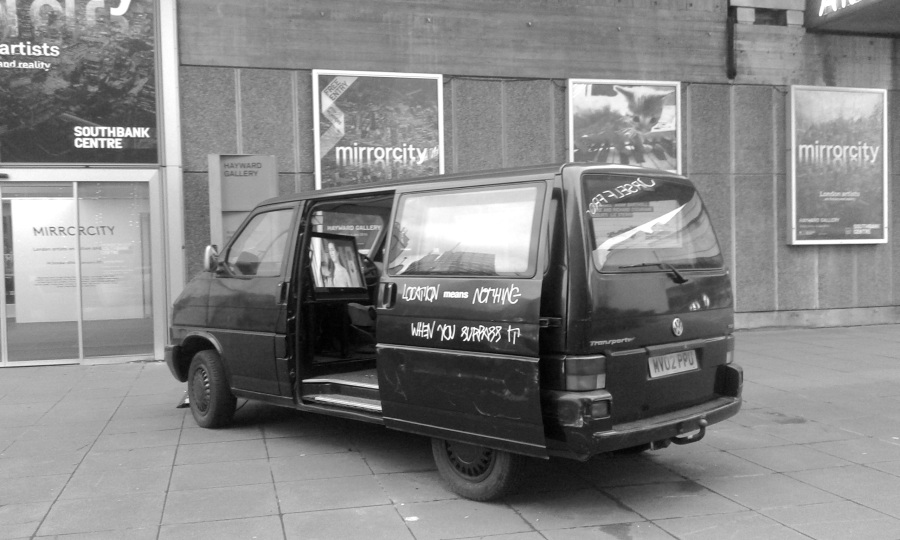
The Southbank’s utopian public spaces, as completed in 1968. Looking East towards The Hayward Gallery. St Pauls Cathedral in the distance.
Today, just outside the Southbank’s Hayward Gallery, and as part of the ‘Mirror City – London Artists On Fiction And Reality’ exhibition, London-based art group Lucky PDF have parked a VW Transporter van with a large LG screen installed and the side door thrown wide open. Anyone can enter, sit, and watch their video ‘How To Leave London’ (2014) without paying the entrance fee for the rest of the show. Thus Lucky PDF nimbly operate as part of a major institutional exhibition while remaining marginal to it.
The film is a sprawling series of interviews that takes over an hour to watch. Mostly you see a new generation confidently discussing the pragmatic arrangements that make their survival as artists possible today. We never see or hear about their works, only the economies, networks and circumstances which have long been the focus of Lucky PDF’s practices. The commitment and conviction of these artists is inspiring and the longer you watch the more you realize the video has much to offer regarding a subject close to your heart, i.e. the fact that London is becoming too expensive for the legions of artists who have contributed their energy, style and imagination to making this city so ‘cool’, ‘vibrant,’ influential and increasingly desirable.
Much of London is currently being flogged off as fast-buck investment portfolios via hastily built towers of brand new apartments that are not really homes but bought-to-rent out at very high prices for parts of the year to non-domiciles while owners watch their original investment magically multiply. It’s a win-win situation if you can afford to buy-in but many who have loved London enough to fight year after year to live here, and have thereby shaped its heart and (dare I say) soul, now feel increasingly unwelcome due to our limited earning and spending power. It’s not difficult to foresee the city becoming a cultural doughnut, the centre hollowed out, featuring nothing but tourist destinations and flats rented at hotel prices, while its dormitory suburbs swell, increasingly crammed with economic migrants.
Lucky PDF however have other suggestions, they’ve been on tour, visiting Berlin, Rotterdam, Athens, Istanbul, Kiev and Warsaw, gleaning stories and opinions from both local and ex-pat Brit artists, curators and writers who have all used the getaway as a survival mechanism. You hear from Mark Dovey, Natasha Hoare, Catriona Gallagher, Sofia Stevi, Natasha Papadopolou and Vova Vorotniov among others, talking of travel and globalization as central to 21st century art and lifestyle. When the PDF crew meet up with Jon Rafman he makes inevitable associations between touring the internet via 2nd Life, Google Street View etc. and the nomadic lives that many contemporary artists now tend to experience.
20th century art nomads may have been pilgrims hurrying to the modern meccas of Paris and New York, or refugees running from war and totalitarian ideology, but the artists here seem to have adopted travel as an adjunct to computer culture and a legacy of the boom in economy air travel. Forget your frozen, anxiety-inducing studio, leave your costly apartment, all you need to make the art of now is a passport, Airbnb account, laptop and shades and you’re sorted. If London is squeezing you out try Athens where there’s no funding structure, no-one can aspire to make art for money and a very different art community is emerging. Berlin is portrayed as a city where you can lock up your bike with a flimsy chain, making London life seem a fortress state-of-mind by comparison.
Watching ‘How To Leave London’ you start to wonder whether you should ever develop strong feelings for a city again, isn’t that ‘so last century?’ And you begin to believe that the countries who fared worst in the financial crash might just come out of it with the most humane environments, while London, where an assertively Right wing government has jettisoned humanity to balance its books while turning the city into a playground where the super-rich profit from everyone else’s environment, may just be the last place on earth where art and artists can thrive and survive.
After more than an hour in the back of a cold van, propped on its welded steel and plywood seating, you begin to note the darkening sky and think about heading along the riverfront to catch Sigmar Polke at Tate Modern. But a look at your watch tells you it’s already too late, and so you wander homeward, wondering, for the umpteenth time, just where you really belong in this world.

Superb
LikeLike
I enjoyed this, although I would point out that being an artist with a studio in London has for all my creative lifetime been difficult, and really the artists that did best in the past have come from privileged backgrounds or were patronised by richer people.
LikeLike
Now, I have no choice but to go and watch. Excellent text. London is becoming just like Paris. Hollowed out and we all run away.
LikeLike
Reblogged this on aliciaheimat.
LikeLike